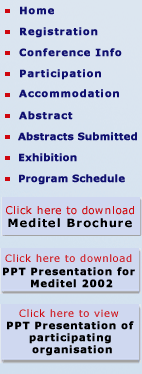| Name |
Vijaylakshmi Kamat |
| Title |
Computer-assisted Decision Support Systems for Patient Management in an eICU with Telemedicine |
| Authors |
Dr.Vijaylakshmi Kamat |
| Institution |
Sri Ramachandra Medical College & Research Institute |
| Abstract |
Artificial intelligence systems help medical and nursing personnel assess patient status, assist in making a diagnosis and help in selecting a therapeutic intervention. The application of the intelligent monitoring techniques of case based reasoning and neural network analysis to physician decision making is an advancement in critical care.
Software such as ART-IM (Automated Reasoning Tool for Information Management) and IDEAS for ICUs (Intelligent Decision Aid System for Intensive Care Units) have been developed as prototypes. This is an alternative to conventional decision-making by the clinician. It compares previous patient experience from a large historical patient database with the new patient and generates an output which helps in the decision making algorithm.
All machines and monitors are interfaced to the computer terminal and real time electronic records are generated. This is linked to a central monitor as well as all other departments through the Internet. Powerful decision making tools are available through web-based technology as well as access to specialist advice through telemedicine. The specialist can access the patient's data and the labs and interventions as well as the trends from his home computer and can advise the on-call doctor.
Experts can remotely monitor and care for ICU patients in multiple locations from a single location (eICU). This provision of remote location 24 hour, 7 days a week telemedicine care led by a senior intensivist, is a means of providing continuous pro-active care and prompt interventions when on-site care is not available. The eICU has access to all clinical information needed to effectively monitor and treat ICU patients remotely. Each team member works at a workstation that provides clinical information including transmission of real time invasive and non-invasive vital signs (exactly as seen on monitors); a complete electronic medical record; a clinical decision support tool and high resolution radiographic images. A tele-conferencing camera provide views of the patient and the room with zoom facilities to focus on monitor screens, infusion pumps and ventilators. On site doctors must provide auscultatory and other findings for which patient contact is essential.
The eICU team places strong emphasis on preventing ICU complications and proactive monitoring is needed to prevent adverse events. Smart alarms are used to herald adverse events.
The ability to integrate and process multiple physiological parameters (eg. a minor increase in respiratory rate becomes significant if accompanied by a drop in oxygen saturation) improves sensitivity and specificity.
|
| Presentation Type |
Power Point Slides |
| Requirements |
Data Projector |


